|
|
 |
Fractals
Natures pattern... |
|
|
|
 | Fractals > Fractals in 3-dimensional (adding 'z') |  |
Popular 3D fractal algorithms
• Mandelbulb
• Mandelbox
• Quaternion Julia Set
• Menger Sponge Fractal
• Tetrahex Fractal
• Sierpinski Tetrahedron Fractal
• Fractal Cube
 | Mandelbulb Fractal JavaScript |  |
Click to Show Details
<html lang="en">
<head>
<meta charset="UTF-8">
<meta name="viewport" content="width=device-width, initial-scale=1.0">
<title>Mandelbulb 3D Fractal</title>
<style>
body {
margin: 0;
width: 100vw;
height: 100vh;
background-color:black;
}
canvas {
width: 100%;
height: 100%;
display: block;
}
</style>
</head>
<body>
<canvas id="mandelbulbCanvas"></canvas>
<script>
const canvas = document.querySelector("#mandelbulbCanvas");
const gl = canvas.getContext("webgl");
function main() {
const vs = `
attribute vec4 a_position;
void main() {
gl_Position = a_position;
}
`;
var fs = `
precision highp float;
#define march_iter 128
#define m_step 0.25
#define z_near 0.01
#define z_far 3.0
#define z_max 1.5
#define mandlebrot_iters 32
uniform vec3 iResolution;
vec3 colorMap( in float t, in vec3 a, in vec3 b, in vec3 c, in vec3 d )
{
return a + b*cos( 6.28318*(c*t+(b*d/a)) );
}
vec3 colorPallete (float t) {
return colorMap( t, vec3(0.5,0.5,0.5),vec3(0.5,0.5,0.5),vec3(0.01,0.01,0.01),vec3(0.00, 0.15, 0.20) );
}
vec2 mandelbulb(vec3 pos) {
float pwr = 3.0+4.0;
vec3 z = pos;
float dr = 1.0;
float r = 0.0;
for (int i = 0; i < mandlebrot_iters ; i++) {
r = length(z);
if (r>z_max) break;
float theta = acos(z.z/r);
float phi = atan(z.y,z.x);
dr = pow( r, pwr-1.0)*pwr*dr + 1.0;
float zr = pow( r,pwr);
theta = theta*pwr;
phi = phi*pwr;
z = zr*vec3(sin(theta)*cos(phi), sin(phi)*sin(theta), cos(theta));
z+=pos;
}
return vec2(0.5*log(r)*r/dr, 50.0*pow(dr,0.128/float(march_iter)));
}
vec2 trace (vec3 origin, vec3 ray) {
float t = 0.0;
float c = 0.0;
for (int i=0; i<march_iter; i++) {
vec3 path = origin + ray * t;
vec2 dist = mandelbulb(path);
t += m_step * dist.x;
c += dist.y;
if (dist.y < z_near) break;
}
return vec2(t,c);
}
void main()
{
vec2 fragCoord = gl_FragCoord.xy;
vec2 uv = fragCoord / iResolution.xy;
uv = uv * 2.0 - 1.0;
uv.x *= iResolution.x / iResolution.y;
vec3 ray = normalize( vec3(uv,1.0));
float rotAngle = 0.5;
ray.xz *= mat2(cos(rotAngle), -sin(rotAngle), sin(rotAngle), cos(rotAngle));
float camDist = z_far*0.55;
vec3 origin = vec3 (camDist * sin(rotAngle),0.0,-camDist *cos(rotAngle));
vec2 depth = trace(origin,ray);
float fog = 1.0 / (1.0 + depth.x * depth.x * 0.1);
vec3 fc = vec3(fog);
gl_FragColor = vec4(colorPallete(depth.y)*fog,1.0);
}
`;
// Compile shader
function compileShader(gl, source, type) {
const shader = gl.createShader(type);
gl.shaderSource(shader, source);
gl.compileShader(shader);
if (!gl.getShaderParameter(shader, gl.COMPILE_STATUS)) {
console.error(`Shader compilation error: ${gl.getShaderInfoLog(shader)}`);
gl.deleteShader(shader);
return null;
}
return shader;
}
const vertexShader = compileShader(gl, vs, gl.VERTEX_SHADER);
const fragmentShader = compileShader(gl, fs, gl.FRAGMENT_SHADER);
// Link shaders into a program
const program = gl.createProgram();
gl.attachShader(program, vertexShader);
gl.attachShader(program, fragmentShader);
gl.linkProgram(program);
if (!gl.getProgramParameter(program, gl.LINK_STATUS)) {
console.error(`Unable to initialize the shader program: ${gl.getProgramInfoLog(program)}`);
return;
}
gl.useProgram(program);
const positionAttributeLocation = gl.getAttribLocation(program, "a_position");
const positionBuffer = gl.createBuffer();
gl.bindBuffer(gl.ARRAY_BUFFER, positionBuffer);
gl.bufferData(gl.ARRAY_BUFFER, new Float32Array([
-1, -1,
1, -1,
-1, 1,
-1, 1,
1, -1,
1, 1,
]), gl.DYNAMIC_DRAW);
gl.viewport(0, 0, gl.canvas.width, gl.canvas.height);
gl.useProgram(program);
var resolution = gl.getUniformLocation(program, 'iResolution');
function render(deltaMS) {
gl.viewport(0, 0, canvas.width, canvas.height);
gl.clear(gl.COLOR_BUFFER_BIT | gl.DEPTH_BUFFER_BIT);
gl.uniform3fv(resolution, [gl.canvas.width, gl.canvas.height, 0]);
gl.enableVertexAttribArray(positionAttributeLocation);
gl.bindBuffer(gl.ARRAY_BUFFER, positionBuffer);
gl.vertexAttribPointer(
positionAttributeLocation,
2,
gl.FLOAT,
false,
0,
0,
);
gl.drawArrays(
gl.TRIANGLES,
0,
6,
);
window.requestAnimationFrame(render);
}
window.requestAnimationFrame(render);
}
main();
</script>
</body>
</html>

Things to Try • Tidy up the code and add in more comments/information
• Try different defaults (e.g., steps and maximum interations)
• Change the colors (instead of the color pallet/try other patterns/gradients)
• Scaling and moving the Bulb around
 | Mandelbox Fractal (JavaScript) |  |
Click to Show Details
<!DOCTYPE html>
<html lang="en">
<head>
<meta charset="UTF-8">
<meta name="viewport" content="width=device-width, initial-scale=1.0">
<title>3D Quaternion Julia Set Fractal</title>
<style>
body { margin: 0; overflow: hidden; }
canvas { display: block; }
</style>
</head>
<body>
<canvas id="webgl-canvas"></canvas>
<script>
document.addEventListener("DOMContentLoaded", function() {
const canvas = document.getElementById('webgl-canvas');
const gl = canvas.getContext('webgl2');
if (!gl) {
console.error('Unable to initialize WebGL. Your browser may not support it.');
return;
}
// Vertex shader program
const vsSource = `
attribute vec4 aVertexPosition;
varying vec2 vUv;
void main(void) {
gl_Position = aVertexPosition;
vUv = aVertexPosition.xy * 0.5 + 0.5;
}
`;
// Fragment shader program
const fsSource = `
precision mediump float;
uniform float iTime;
uniform vec2 iResolution;
//Adjust to fit the box in view
#define CAM_POS vec3(0.0, 0.0, -12.0)
#define LIGHT_POS vec3(2.0, 2.0, -12.0)
//Background radius is 15 - disable it if the box is bigger than this or you need the camera further back.
//#define DISABLE_BG
//Fractal Parameters
#define ITERS 10
#define SCALE 3.0
#define MR2 0.25
//Enables Fresnel reflections - disable to reduce noise
#define SURF_REFL
//Ray march detail - lower numbers increase detail
#define DETAIL 1.0
//Enable 4x super-sampling - greatly reduces noise and your framerate
//#define SS
//GOLDEN MANDELBOX
#define BOX_ROUGHNESS 0.5
#define BOX_METAL 1.0
#define BOX_COLOUR vec3(0.854902, 0.750196, 0.368627)
float closeObj = 0.0;
const float PI = 3.14159;
mat3 rotX(float d){
float s = sin(d);
float c = cos(d);
return mat3(1.0, 0.0, 0.0,
0.0, c, -s,
0.0, s, c );
}
mat3 rotY(float d){
float s = sin(d);
float c = cos(d);
return mat3( c, 0.0, -s,
0.0, 1.0, 0.0,
s, 0.0, c );
}
mat3 rotZ(float d){
float s = sin(d);
float c = cos(d);
return mat3( c, -s, 0.0,
s, c, 0.0,
0.0, 0.0, 1.0);
}
// Mandelbox DE from
// http://www.fractalforums.com/3d-fractal-generation/a-mandelbox-distance-estimate-formula/msg21412/#msg21412
vec4 scalevec = vec4(SCALE, SCALE, SCALE, abs(SCALE)) / MR2;
float C1 = abs(SCALE-1.0), C2 = pow(abs(SCALE), float(1-ITERS));
float mandelbox(vec3 position){
vec4 p = vec4(position.xyz, 1.0), p0 = vec4(position.xyz, 1.0); // p.w is knighty's DEfactor
for (int i=0; i<ITERS; i++) {
p.xyz = clamp(p.xyz, -1.0, 1.0) * 2.0 - p.xyz; // box fold: min3, max3, mad3
float r2 = dot(p.xyz, p.xyz); // dp3
p.xyzw *= clamp(max(MR2/r2, MR2), 0.0, 1.0); // sphere fold: div1, max1.sat, mul4
p.xyzw = p*scalevec + p0; // mad4
}
return (length(p.xyz) - C1) / p.w - C2;
}
vec2 vecMin(vec2 a, vec2 b){
if(a.x <= b.x){
return a;
}
return b;
}
float lastx = 0.0;
float lasty = 0.0;
vec2 mapMat(vec3 p){
vec2 box = vec2(mandelbox(rotZ(radians(lastx) / 1.5) * rotX(radians(lasty) / 1.5) * p), 3.0);
#ifdef DISABLE_BG
return box;
#endif
vec2 cmap = vec2(-length(p) + 15.0, 1.0);
return vecMin(box, cmap);
}
//Returns the min distance
float map(vec3 p){
return mapMat(p).x;
}
float trace(vec3 ro, vec3 rd){
float t = 0.5;
float d = 0.0;
float w = 1.3;
float ld = 0.0;
float ls = 0.0;
float s = 0.0;
float cerr = 10000.0;
float ct = 0.0;
float pixradius = DETAIL / iResolution.y;
vec2 c;
int inter = 0;
for(int i = 0; i < 256; i++){
ld = d;
c = mapMat(ro + rd * t);
d = c.x;
//Detect intersections missed by over-relaxation
if(w > 1.0 && abs(ld) + abs(d) < s){
s -= w * s;
w = 1.0;
t += s;
continue;
}
s = w * d;
float err = d / t;
if(abs(err) < abs(cerr)){
ct = t;
cerr = err;
}
//Intersect when d / t < one pixel
if(abs(err) < pixradius){
inter = 1;
break;
}
t += s;
if(t > 30.0){
break;
}
}
closeObj = c.y;
if(inter == 0){
ct = -1.0;
}
return ct;
}
//Approximate normal
vec3 normal(vec3 p){
return normalize(vec3(map(vec3(p.x + 0.0001, p.yz)) - map(vec3(p.x - 0.0001, p.yz)),
map(vec3(p.x, p.y + 0.0001, p.z)) - map(vec3(p.x, p.y - 0.0001, p.z)),
map(vec3(p.xy, p.z + 0.0001)) - map(vec3(p.xy, p.z - 0.0001))));
}
vec3 camPos = vec3(0.0);
vec3 lightPos = vec3(0.0);
//Determine if a point is in shadow - 1.0 = not in shadow
float shadow(vec3 ro, vec3 rd){
float t = 0.01;
float d = 0.0;
float shadow = 1.0;
for(int iter = 0; iter < 128; iter++){
d = map(ro + rd * t);
if(d < 0.0001){
return 0.0;
}
if(t > length(ro - lightPos) - 0.5){
break;
}
shadow = min(shadow, 128.0 * d / t);
t += d;
}
return shadow;
}
float occlusion(vec3 ro, vec3 rd){
float k = 1.0;
float d = 0.0;
float occ = 0.0;
for(int i = 0; i < 10; i++){
d = map(ro + 0.1 * k * rd);
occ += 1.0 / pow(2.0, k) * (k * 0.1 - d);
k += 1.0;
}
return 1.0 - clamp(occ * 3.0, 0.0, 1.0);
}
//Square
float sqr(float x){
return x * x;
}
//Diffusion normalisation
float diff(float albedo){
return albedo / PI;
}
//GGX NDF
float specD(float NdotH, float a){
float asqr = sqr(a);
float NdotHsqr = sqr(NdotH);
return asqr / (PI * sqr((NdotHsqr) * (asqr - 1.0) + 1.0));
}
float G1(float NdotX, float k){
return NdotX / (NdotX * (1.0 - k) + k);
}
//Geometric attenuation term
float specG(float NdotV, float NdotL, float k){
k /= 2.0;
return G1(NdotV, k) * G1(NdotL, k);
}
//Schlick fresnel approximation used by Unreal Engine
float fresnel(float AdotB){
float power = pow(2.0, (-5.55473 * AdotB - 6.98316) * AdotB);
return 0.04 + (1.0 - 0.04) * power;
}
vec3 BRDF(vec3 L, vec3 V, vec3 N, vec3 c, vec3 lc, float metallic, float roughness, float s, float o, float ccr){
vec3 H = normalize(L + V);
float NdotH = dot(N, H);
float NdotL = dot(N, L);
float NdotV = dot(N, V);
if (NdotL < 0.0 || NdotV < 0.0) return vec3(0.0);
float VdotH = dot(V, H);
float alpha = roughness * roughness;
float conductor = 1.0 - metallic;
c = c - (0.4 - 0.4 * s) * c;
vec3 specCol = mix(vec3(1.0), c, metallic);
float FresL = fresnel(NdotL);
float FresV = fresnel(NdotV);
float Fresd90 = 0.5 + 2.0 * sqr(VdotH) * roughness;
float Fresd = mix(1.0, Fresd90, FresL) * mix(1.0, Fresd90, FresV);
float Ds = specD(NdotH, alpha);
float FresH = fresnel(VdotH);
vec3 Fress = mix(specCol, vec3(1.0), FresH);
float Gs = specG(NdotV, NdotL, roughness);
vec3 ccSpec = vec3(0.0);
if(ccr > 0.0){
float ccDs = specD(NdotH, sqr(ccr));
vec3 ccFress = vec3(1.0);
float ccGs = specG(NdotV, NdotL, ccr);
ccSpec = ccDs * ccFress * ccGs * floor(s);
}
vec3 ref = vec3(0.0);
/*
#ifdef SURF_REFL
if(roughness > 0.5){
ref = pow(texture(iChannel1, reflect(V, N)).xyz, vec3(2.2)) * specCol * FresV;
}else{
ref = pow(texture(iChannel0, reflect(V, N)).xyz, vec3(2.2)) * specCol * FresV;
}
#endif
*/
return ((diff(conductor) * Fresd * max(0.0, NdotL) * o * c + Gs * Fress * Ds * floor(s) + ccSpec) + ref) * lc;
}
vec3 colour(vec3 p, float id){
vec3 n = normal(p);
vec3 l = normalize(lightPos - p);
vec3 v = normalize(camPos - p);
vec3 lc = pow(vec3(1.0, 0.72549, 0.631373), vec3(2.2));
float o = occlusion(p, n);
if(id == 1.0){
return vec3(0.2); // pow(texture(iChannel0, n).xyz, vec3(2.2));
}
if(id == 3.0){
float s = shadow(p, l);
vec3 col = BOX_COLOUR;
col = pow(col, vec3(1.0 / 0.4545));
return BRDF(l, v, n, col, lc, BOX_METAL, BOX_ROUGHNESS, s, o, 0.0);
}
return vec3(0.0, 1.0, 0.0);
}
void main() // mainImage( out vec4 fragColor, in vec2 fragCoord ){
{
vec2 fragCoord = gl_FragCoord.xy;
vec2 uv = fragCoord.xy / iResolution.xy;
uv = uv * 2.0 - 1.0;
uv.x *= iResolution.x / iResolution.y;
camPos = CAM_POS;
lightPos = LIGHT_POS;
//lastx += iMouse.x - 0.5;
//lasty += iMouse.y - 0.5;
vec3 ro = camPos;
vec3 rd = normalize(vec3(uv, 1.5));
float d = trace(ro, rd);
vec3 c = ro + rd * d;
vec3 col = vec3(1.0);
//If intersected
if(d > 0.0){
//Colour the point
col = colour(c, closeObj);
}else{
col = vec3(0.0);
}
#ifdef SS
vec3 ssro = camPos;
vec3 ssrd = normalize(vec3(uv.x + 0.5/iResolution.x, uv.y, 1.5));
float ssd = trace(ssro, ssrd);
vec3 ssc = ssro + ssrd * ssd;
vec3 colss;
//If intersected
if(d > 0.0){
//Colour the point
colss = colour(ssc, closeObj);
col = (colss + col) / vec3(2.0);
}else{
col = (vec3(0.0) + col) / vec3(2.0);
}
ssrd = normalize(vec3(uv.x + 0.5/iResolution.x, uv.y + 0.5/iResolution.y, 1.5));
ssd = trace(ssro, ssrd);
ssc = ssro + ssrd * ssd;
//If intersected
if(d > 0.0){
//Colour the point
colss = colour(ssc, closeObj);
col = (colss + col) / vec3(2.0);
}else{
col = (vec3(0.0) + col) / vec3(2.0);
}
ssrd = normalize(vec3(uv.x, uv.y + 0.5/iResolution.y, 1.5));
ssd = trace(ssro, ssrd);
ssc = ssro + ssrd * ssd;
//If intersected
if(d > 0.0){
//Colour the point
colss = colour(ssc, closeObj);
col = (colss + col) / vec3(2.0);
}else{
col = (vec3(0.0) + col) / vec3(2.0);
}
#endif
//col *= 1.0 / exp(d * 0.25);
col = pow( col, vec3(0.4545) );
gl_FragColor = vec4(col,1.0);
}
`;
function compileShader(gl, source, type) {
const shader = gl.createShader(type);
gl.shaderSource(shader, source);
gl.compileShader(shader);
if (!gl.getShaderParameter(shader, gl.COMPILE_STATUS)) {
console.error(`Shader compilation error: ${gl.getShaderInfoLog(shader)}`);
gl.deleteShader(shader);
return null;
}
return shader;
}
const vertexShader = compileShader(gl, vsSource, gl.VERTEX_SHADER);
const fragmentShader = compileShader(gl, fsSource, gl.FRAGMENT_SHADER);
if (!vertexShader || !fragmentShader) {
return;
}
const program = gl.createProgram();
gl.attachShader(program, vertexShader);
gl.attachShader(program, fragmentShader);
gl.linkProgram(program);
if (!gl.getProgramParameter(program, gl.LINK_STATUS)) {
console.error(`Program linking error: ${gl.getProgramInfoLog(program)}`);
return;
}
gl.useProgram(program);
// Create a buffer and put a single clipspace cube in it
const positionBuffer = gl.createBuffer();
gl.bindBuffer(gl.ARRAY_BUFFER, positionBuffer);
const positions = new Float32Array([
-1.0, -1.0, -1.0,
1.0, -1.0, -1.0,
-1.0, 1.0, -1.0,
1.0, 1.0, -1.0,
-1.0, -1.0, 1.0,
1.0, -1.0, 1.0,
-1.0, 1.0, 1.0,
1.0, 1.0, 1.0,
]);
gl.bufferData(gl.ARRAY_BUFFER, positions, gl.STATIC_DRAW);
const positionAttrib = gl.getAttribLocation(program, 'aVertexPosition');
gl.vertexAttribPointer(positionAttrib, 3, gl.FLOAT, false, 0, 0);
gl.enableVertexAttribArray(positionAttrib);
// Set up uniforms
const timeUniformLocation = gl.getUniformLocation(program, 'iTime');
const resolutionUniformLocation = gl.getUniformLocation(program, 'iResolution');
function resizeCanvas() {
canvas.width = window.innerWidth;
canvas.height = window.innerHeight;
gl.viewport(0, 0, canvas.width, canvas.height);
gl.uniform2f(resolutionUniformLocation, canvas.width, canvas.height);
}
window.addEventListener('resize', resizeCanvas);
resizeCanvas();
function render() {
gl.uniform1f(timeUniformLocation, performance.now() * 0.001);
gl.clear(gl.COLOR_BUFFER_BIT);
gl.drawArrays(gl.TRIANGLE_STRIP, 0, 8);
//requestAnimationFrame(render);
}
render();
render();
render();
});
</script>
</body>
</html>
Output should look like this:

Things to Try • Try reducing and simplifiying the code (also adding in your own comments/notes)
• Modify the colors (mix of gradients and patterns)
• Change the parameters to create different patterns/configurations
• Randomness - add in some random values into the equation
• Move the cube around (location and rotation)
• Extend the previous one to draw a second cube at a different location (multiple cubes)
 | Quaternion Fractal Juliet Set |  |
Click to Show Details
<!DOCTYPE html>
<html lang="en">
<head>
<meta charset="UTF-8">
<meta name="viewport" content="width=device-width, initial-scale=1.0">
<title>3D Quaternion Julia Set Fractal</title>
<style>
body { margin: 0; overflow: hidden; }
canvas { display: block; }
</style>
</head>
<body>
<canvas id="webgl-canvas"></canvas>
<script>
document.addEventListener("DOMContentLoaded", function() {
const canvas = document.getElementById('webgl-canvas');
const gl = canvas.getContext('webgl2');
if (!gl) {
console.error('Unable to initialize WebGL. Your browser may not support it.');
return;
}
// Vertex shader program
const vsSource = `
attribute vec4 aVertexPosition;
varying vec2 vUv;
void main(void) {
gl_Position = aVertexPosition;
vUv = aVertexPosition.xy * 0.5 + 0.5;
}
`;
// Fragment shader program
const fsSource = `
precision mediump float;
uniform float iTime;
uniform vec2 iResolution;
// Quick little function to multiply two quaternions.
// The proof is left as an exercise to the reader
vec4 MultiplyQuaternions(vec4 a, vec4 b)
{
float real = a.w*b.w - dot(a.xyz, b.xyz);
vec3 complex = (a.w*b.xyz + b.w*a.xyz + cross(a.xyz, b.xyz));
return vec4(complex, real);
}
// Convert degrees to radians
float Radians(float deg)
{
return deg / 360.0 * 2.0 * 3.14159;
}
// Write a float4 function for some of the HLSL Code conversion
vec4 float4(float x, float y, float z, float w)
{
return vec4(x,y,z,w);
}
// Write a float3 function for the same purpose
vec3 float3(float x, float y, float z)
{
return vec3(x,y,z);
}
// Exact SDF for a sphere
float dSphere(vec3 pos, vec3 center, float radius)
{
// find the distance to the center
vec3 v = pos - center;
// return that, minus the radius
return length(v) - radius;
}
// Exact intersection of a sphere. Resolves a quatratic equation. Returns the
// min distance, max distance, and discriminant to determine if the intersections
// actually exist.
vec3 intersections_of_sphere(vec3 pos_vector, vec3 dir_vector, float sphere_radius)
{
// Derivation for formula:
// Let the ray be represented as a point P plus a scalar multiple t of the direction vector v,
// The ray can then be expressed as P + vt
//
// The point of intersection I = (x, y, z) must be expressed as this, but must also be some distance r
// from the center of the sphere, thus x*x + y*y + z*z = r*r, or in vector notation, I*I = r*r
//
// It therefore follows that (P + vt)*(P + vt) = r*r, or when expanded and rearranged,
// (v*v)t^2 + (2P*v)t + (P*P - r*r) = 0. For this we will use the quadratic equation for the points of
// intersection
// a, b, and c correspond to the second, first, and zeroth order terms of t, the parameter we are trying to solve for.
float a = dot(dir_vector, dir_vector);
float b = 2.0 * dot(pos_vector, dir_vector);
float c = dot(pos_vector, pos_vector) - sphere_radius * sphere_radius;
// to avoid imaginary number, we will find the absolute value of the discriminant.
float discriminant = b * b - 4.0 * a*c;
float abs_discriminant = abs(discriminant);
float min_dist = (-b - sqrt(abs_discriminant)) / (2.0 * a);
float max_dist = (-b + sqrt(abs_discriminant)) / (2.0 * a);
// return the two intersections, along with the discriminant to determine if
// the intersections actually exist.
return float3(min_dist, max_dist, discriminant);
}
// Distance estimation for a julia set.
float DE(vec3 p, vec3 c, vec4 seed)
{
// First, offset the point by the center
vec3 v = p - c;
// Set C to be a vector of constants determining julia set we use
vec4 C = seed;
// Set Z to be some form of input from the vector
vec4 Z = float4(v.z, v.y, 0.0, v.x);
// I'll be honest, I'm not entirely sure how the distance estimation works.
// Calculate the derivative of Z. The Julia set we are using is Z^2 + C,
// So this results in simply 2z
vec4 dz = 2.0*Z + vec4(1.0, 1.0, 1.0, 1.0);
// Run the iterative loop for some number of iterations
for (int i = 0; i < 64; i++)
{
// Recalculate the derivative
dz = 2.0 * MultiplyQuaternions(Z, dz) + vec4(1.0, 1.0, 1.0, 1.0);
// Rcacalculate Z
Z = MultiplyQuaternions(Z, Z) + C;
// We rely on the magnitude of z being fairly large (the derivation includes
// A limit as it approaches infinity) so we're going to let it run for a bit longer
// after we know its going to explode. i.e. 1000 instead of the usual, like 8.
if (dot(Z, Z) > 1000.0)
{
break;
}
}
// And this is where the witchcraft happens. Again, not sure how this works, but as
// you can see, it does.
float d = 0.5*sqrt(dot(Z, Z) / dot(dz, dz))*log(dot(Z, Z)) / log(10.0);
// Return the distance estimation.
return d;
}
void main()
{
vec2 fragCoord = gl_FragCoord.xy;
// Define the iterations for the marcher.
const int ITERATIONS = 200;
// Define the roation speed. Set to 0 to disable
const float ROTATION_SPEED = 0.6;
// Define the start angle for the rotation (in degrees)
const float START_ANGLE = 0.0;
// Define the orbit radius
const float ORBIT_RADIUS = 2.5;
// Define the epsilon value for closeness to be considered a hit
const float EPSILON = 0.001;
// Define if we should invert the color at the end
const bool DARK_MODE = true;
//vec4 julia_seed = vec4(0.0, -0.2, 0.0, -1.17);
//vec4 julia_seed = vec4(0.2, 0.67, 0.0, -0.5);
vec4 julia_seed = vec4(0.33, 0.56, 0.0, -0.72);
//vec4 julia_seed = vec4(-0.15, -0.15, 0.0, -.95);
// Define the center of the julia set
vec3 julia_center = vec3(0.0, 0.0, 0.0);
// Calculate the starting angles for the orbit
float theta = iTime * ROTATION_SPEED;
float phi = Radians(START_ANGLE);
// Define an orbital path based on time
vec3 orbit = vec3(cos(theta)*cos(phi), sin(phi), sin(theta)*cos(phi));
// Cacluate the normal of the path. Since its a circle, it will just
// be back down into the center
vec3 normal = -normalize(orbit);
// Calculate the tangent of the path
// A circle consists of <cost, sint>, which when differentiated yields
// <-sint, cost>. since z is already sint, and x is already cost, the equation
// is as follows.
vec3 tangent = normalize(vec3(-normal.z, 0.0, normal.x));
// Calculate the UV coordinates
vec2 uv = fragCoord/iResolution.xy;
// Convert the UV coordinates to a range between -1 and 1
vec2 range = uv*2.0 - vec2(1.0,1.0);
// Define the Camera position
vec3 cam_pos = orbit*ORBIT_RADIUS;
// Define the forward, up, and right vectors (needs rework)
vec3 forward = normal;
vec3 up = normalize(cross(normal, tangent));
vec3 right = tangent;
// Calculate the aspect ratio of the screen
float aspect = float(iResolution.y) / float(iResolution.x);
// Calculate the ray as a normalized combination of the forward, right, and up vectors.
// Note that the purely forward + horizonal combination yield vectors 45 degrees outward
// for a 90 degree field of view. This may be updated with a fov option
vec3 ray = normalize(forward + range.x*right + range.y*up*aspect);
// Initialize the ray marched point p
vec3 p = cam_pos;
// Initialize the distance
float dist = 1.0;
// Calculate the exact distance from a sphere of radius 2 using a raytracing function
vec3 init_distance = intersections_of_sphere(p - julia_center, ray, 2.0);
// If we are outside a bubble around the raymarched fractal
if (init_distance.z > 0.0)
{
// Step onto the sphere so we start off a bit closer.
p += ray * clamp(init_distance.x, 0.0, init_distance.x);
}
// declare a dummy variable to store the number of iterations into.
// I'm doing it this way because on my phone it didnt let me use an
// already declared variable as the loop iterator.
int j;
float minDist = 1000.0;
vec3 closestPoint = vec3(0.0,0.0,0.0);
// Begin the raymarch
for (int i = 0; i < ITERATIONS; i++)
{
// Estimate the distance to the julia set
dist = DE(p, julia_center, julia_seed);
if (dist < minDist)
{
closestPoint = p;
}
// Move forward that distance
p += ray*dist;
// Record the number of iterations we are on
j = i;
// If we hit the julia set, or get too far away form it
if (dist < EPSILON || dot(p - julia_center, p-julia_center) > 8.1)
{
// Break the loop.
break;
}
}
// calculate the brightness based on iterations used
float di = float(j) / float(ITERATIONS);
// determine if we hit the fractal or not
float hit = step(dist, EPSILON);
if (!DARK_MODE)
{
di = 1.0 - di;
}
// define some phase angle
float psi = Radians(70.0);
// Time varying pixel color (included in default shadertoy project)
vec3 col = 0.8 + 0.2*cos(iTime*0.5+uv.xyx+vec3(0,2,4) + psi*hit);
// Boring old white instead of the above commented code. Will tweak rendering later
//vec3 col = vec3(0.7,1.0,.93);
// Output to screen. Modifiy the color with the brightness calculated as di.
gl_FragColor = vec4(col*di,1.0);
}
`;
function compileShader(gl, source, type) {
const shader = gl.createShader(type);
gl.shaderSource(shader, source);
gl.compileShader(shader);
if (!gl.getShaderParameter(shader, gl.COMPILE_STATUS)) {
console.error(`Shader compilation error: ${gl.getShaderInfoLog(shader)}`);
gl.deleteShader(shader);
return null;
}
return shader;
}
const vertexShader = compileShader(gl, vsSource, gl.VERTEX_SHADER);
const fragmentShader = compileShader(gl, fsSource, gl.FRAGMENT_SHADER);
if (!vertexShader || !fragmentShader) {
return;
}
const program = gl.createProgram();
gl.attachShader(program, vertexShader);
gl.attachShader(program, fragmentShader);
gl.linkProgram(program);
if (!gl.getProgramParameter(program, gl.LINK_STATUS)) {
console.error(`Program linking error: ${gl.getProgramInfoLog(program)}`);
return;
}
gl.useProgram(program);
// Create a buffer and put a single clipspace cube in it
const positionBuffer = gl.createBuffer();
gl.bindBuffer(gl.ARRAY_BUFFER, positionBuffer);
const positions = new Float32Array([
-1.0, -1.0, -1.0,
1.0, -1.0, -1.0,
-1.0, 1.0, -1.0,
1.0, 1.0, -1.0,
-1.0, -1.0, 1.0,
1.0, -1.0, 1.0,
-1.0, 1.0, 1.0,
1.0, 1.0, 1.0,
]);
gl.bufferData(gl.ARRAY_BUFFER, positions, gl.STATIC_DRAW);
const positionAttrib = gl.getAttribLocation(program, 'aVertexPosition');
gl.vertexAttribPointer(positionAttrib, 3, gl.FLOAT, false, 0, 0);
gl.enableVertexAttribArray(positionAttrib);
// Set up uniforms
const timeUniformLocation = gl.getUniformLocation(program, 'iTime');
const resolutionUniformLocation = gl.getUniformLocation(program, 'iResolution');
function resizeCanvas() {
canvas.width = window.innerWidth;
canvas.height = window.innerHeight;
gl.viewport(0, 0, canvas.width, canvas.height);
gl.uniform2f(resolutionUniformLocation, canvas.width, canvas.height);
}
window.addEventListener('resize', resizeCanvas);
resizeCanvas();
function render() {
gl.uniform1f(timeUniformLocation, performance.now() * 0.001);
gl.clear(gl.COLOR_BUFFER_BIT);
gl.drawArrays(gl.TRIANGLE_STRIP, 0, 8);
//requestAnimationFrame(render);
}
render();
render();
render();
});
</script>
</body>
</html>
Output should look like this:

Things to Try • Tidy up the code (try and make it more concise and compact)
• Add in more comments
• Animate the visualization (rotates and can view it from other angles)
• Animate the fractal effect (e.g., increment the parameters so it animates/changes gradually)
• Randomness - insert a bit of randomness into the calculation
• Move the object around (e.g., offset position, x, y and z)
• Draw 2 quaternion fractals on screen at different locations
• Colors - use different colors/gradients to visualize the fractal in differnet ways
 | 3D Menger Sponge Fractal (JavaScript and P5) |  |
Click to Show Details
<!--
Menger Sponge Fractal - click to the mouse to subdivide
-->
<style>
body {
background-color: rgb(200, 200, 200);
min-height: 600px;
}
canvas {
margin: auto;
}
</style>
<script src='https://cdnjs.cloudflare.com/ajax/libs/p5.js/0.7.1/p5.min.js'></script>
<script>
let a = 0;
let b;
let sponge = new Array();
const recursiveLimit = 4;
let recursiveCount = 0;
let clickSe;
function setup() {
createCanvas(600, 600, WEBGL);
ambientLight(100);
directionalLight(120, 120, 120, -1, -1, 1);
ambientMaterial(230, 210, 255, 255);
noStroke();
resetCube();
}
function mousePressed() {
++recursiveCount;
if (recursiveCount >= recursiveLimit) {
resetCube();
return;
}
let next = new Array();
sponge.forEach(abox => {
let newBoxes = abox.generate();
next = concat(next, newBoxes);
});
sponge = next;
}
function draw() {
camera(0, 0, 500, 0, 0, 0, 0, 1, 0);
background(30, 30, 60);
rotateX(a);
rotateY(a * 0.4);
rotateZ(a * 0.1);
sponge.forEach(abox => { abox.show(); });
a += 0.01;
}
function resetCube() {
b = new Box(0, 0, 0, 300);
sponge = [b];
recursiveCount = 0;
}
class Box {
constructor(x, y, z, r_) {
this.pos = createVector(x, y, z);
this.r = r_;
}
generate() {
let boxes = new Array();
for (let x = -1; x < 2; x++) {
for (let y = -1; y < 2; y++) {
for (let z = -1; z < 2; z++) {
let sum = abs(x) + abs(y) + abs(z);
const newR = this.r / 3;
if (sum > 1) {
let b = new Box(this.pos.x + x * newR, this.pos.y + y * newR, this.pos.z + z * newR, newR);
boxes.push(b);
}
}
}
}
return boxes;
}
show() {
push();
translate(this.pos.x, this.pos.y, this.pos.z);
box(this.r);
pop();
}
}
console.log('click cube to do the Menger Sponge Fractal')
console.log('ready...');
</script>
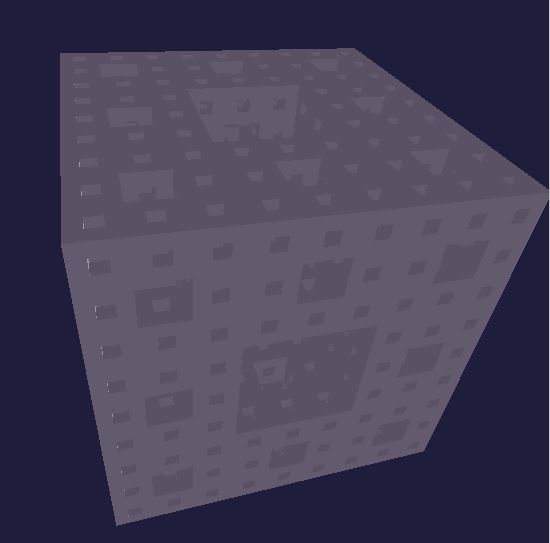
Things to Try • Try making the different cubes a different color
• Draw wireframe information
 | Sierpinski Fractal (Tetrahedron) |  |
Click to Show Details
<!DOCTYPE html>
<html lang="en">
<head>
<meta charset="UTF-8">
<meta name="viewport" content="width=device-width, initial-scale=1.0">
<title>Sierpinski 3D Fractal</title>
<script src='https://cdnjs.cloudflare.com/ajax/libs/gl-matrix/2.6.0/gl-matrix-min.js'></script>
<style>
body { margin: 0; }
canvas { display: block; }
</style>
</head>
<body>
<canvas id="sierpinskiCanvas" width='500' height='500'></canvas>
<script>
/*
sierpinski 3d - build geometry
*/
let baseColors = [
[1.0, 0.0, 0.36],
[0.61, 1.0, 0.3],
[1.0, 0.52, 0.14],
[1.0, 0.0, 1.0]
]
// creating a simple series of points
let vertices = [
[0.0000, -0.1500, -1.0000],
[0.0000, 0.8428, 0.3333],
[-0.8165, -0.5714, 0.3333],
[0.8165, -0.5714, 0.3333]
]
let points = []
let colors = []
function flatten(array) {
let f = new Float32Array(array.length*3)
array.forEach(function (point, index) {
f[index*3] = point[0]
f[index*3+1] = point[1]
f[index*3+2] = point[2]
})
return f
}
// utility to scale a vector
function scale(point, scale) {
return [point[0]*scale, point[1]*scale, point[2]*scale]
}
function triangle (a, b, c, color) {
colors.push(scale(baseColors[color], 1))
points.push(a)
colors.push(scale(baseColors[color], 1))
points.push(b)
colors.push(baseColors[color])
points.push(c)
}
function tetra (a, b, c, d) {
triangle(a, c, b, 0)
triangle(a, c, d, 1)
triangle(a, b, d, 2)
triangle(b, c, d, 3)
}
function getMiddlePoint(u, v){
return [0.5*(u[0] + v[0]), 0.5* (u[1] + v[1]), 0.5* (u[2] + v[2])]
}
function divideTetra(a, b, c, d, count) {
if(count===0){
tetra(a, b, c, d)
return
}
let ab = getMiddlePoint(a, b)
let ac = getMiddlePoint(a, c)
let ad = getMiddlePoint(a, d)
let bc = getMiddlePoint(b, c)
let bd = getMiddlePoint(b, d)
let cd = getMiddlePoint(c, d)
--count
divideTetra(a, ab, ac, ad, count)
divideTetra(ab, b, bc, bd, count)
divideTetra(ac, bc, c, cd, count)
divideTetra(ad, bd, cd, d, count)
}
divideTetra(vertices[0], vertices[1], vertices[2], vertices[3], 3);
let vcolors = flatten(colors);
let vpositions = flatten(points);
console.log('num points (3 points per triangle):', points.length );
// -------------------------------------
// Vertex shader program
const vsSource = `
attribute vec4 aVertexPosition;
uniform mat4 uModelViewMatrix;
uniform mat4 uProjectionMatrix;
void main(void) {
gl_Position = uProjectionMatrix * uModelViewMatrix * aVertexPosition;
}
`;
// Fragment shader program
const fsSource = `
precision mediump float;
void main(void) {
gl_FragColor = vec4(1.0, 1.0, 1.0, 1.0);
}
`;
// Initialize WebGL
const canvas = document.getElementById('sierpinskiCanvas');
const gl = canvas.getContext('webgl');
if (!gl) { console.error('Unable to initialize WebGL. Your browser may not support it.'); }
// Compile shaders, create program, and link it
function initShaderProgram(gl, vsSource, fsSource) {
const vertexShader = loadShader(gl, gl.VERTEX_SHADER, vsSource);
const fragmentShader = loadShader(gl, gl.FRAGMENT_SHADER, fsSource);
const shaderProgram = gl.createProgram();
gl.attachShader(shaderProgram, vertexShader);
gl.attachShader(shaderProgram, fragmentShader);
gl.linkProgram(shaderProgram);
if (!gl.getProgramParameter(shaderProgram, gl.LINK_STATUS)) {
console.error('Unable to initialize the shader program: ' + gl.getProgramInfoLog(shaderProgram));
return null;
}
return shaderProgram;
}
// Compile shader
function loadShader(gl, type, source) {
const shader = gl.createShader(type);
gl.shaderSource(shader, source);
gl.compileShader(shader);
if (!gl.getShaderParameter(shader, gl.COMPILE_STATUS)) {
console.error('An error occurred compiling the shaders: ' + gl.getShaderInfoLog(shader));
gl.deleteShader(shader);
return null;
}
return shader;
}
const shaderProgram = initShaderProgram(gl, vsSource, fsSource);
gl.useProgram(shaderProgram);
// Set up a buffer to hold the Sierpinski fractal vertices
const vertexBuffer = gl.createBuffer();
gl.bindBuffer(gl.ARRAY_BUFFER, vertexBuffer);
gl.bufferData(gl.ARRAY_BUFFER, vpositions, gl.STATIC_DRAW);
const position = gl.getAttribLocation(shaderProgram, 'aVertexPosition');
gl.vertexAttribPointer(position, 3, gl.FLOAT, false, 0, 0);
gl.enableVertexAttribArray(position);
// Set up matrices for projection and model view
const projectionMatrix = mat4.create();
const modelViewMatrix = mat4.create();
// Set up the projection matrix
mat4.perspective(projectionMatrix, Math.PI / 4, canvas.width / canvas.height, 1, 100);
const uProjectionMatrix = gl.getUniformLocation(shaderProgram, 'uProjectionMatrix');
gl.uniformMatrix4fv(uProjectionMatrix, false, projectionMatrix);
// Set up the model view matrix
mat4.lookAt(modelViewMatrix, [0, 0, 3], [0, 0, 0], [0.1, 1, 0]);
const uModelViewMatrix = gl.getUniformLocation(shaderProgram, 'uModelViewMatrix');
gl.uniformMatrix4fv(uModelViewMatrix, false, modelViewMatrix);
// Set the clear color and enable depth testing
gl.clearColor(0.0, 0.0, 0.0, 1.0);
gl.clear(gl.COLOR_BUFFER_BIT | gl.DEPTH_BUFFER_BIT);
gl.enable(gl.DEPTH_TEST);
// Draw the Sierpinski fractal
gl.drawArrays(gl.TRIANGLES, 0, vpositions.length / 3);
</script>
</body>
</html>

Things to Try • Add the colors into the program (color values are calculated but not passed to the shader - for you todo)
• Animate the shape so it rotates
• Move the position so it's offset and draw a second one (multiple Sierpinski pyramids)
• Randomness - insert some randomness into the recursive loop (just a small amount but enough to make thing interesting)
 | Tetrahex Fractal (3D) |  |
Click to Show Details
<html lang="en">
<head>
<meta charset="UTF-8">
<meta name="viewport" content="width=device-width, initial-scale=1.0">
<title>3D Tetrahex Fractal</title>
<style>
body { margin: 0; }
canvas { display: block; }
</style>
</head>
<body>
<canvas id="fractalCanvas" width='600' height='600' ></canvas>
<script>
// WebGL setup
const canvas = document.getElementById('fractalCanvas');
const gl = canvas.getContext('webgl');
if (!gl) {
console.error('Unable to initialize WebGL. Your browser may not support it.');
}
// Vertex and fragment shaders
const vertexShaderSource = `
attribute vec4 a_position;
uniform mat4 u_modelViewMatrix;
void main() {
gl_Position = u_modelViewMatrix * a_position;
}
`;
const fragmentShaderSource = `
precision mediump float;
void main() {
gl_FragColor = vec4(1.0, 1.0, 1.0, 1.0);
}
`;
// Compile shaders
function compileShader(gl, source, type) {
const shader = gl.createShader(type);
gl.shaderSource(shader, source);
gl.compileShader(shader);
if (!gl.getShaderParameter(shader, gl.COMPILE_STATUS)) {
console.error('Shader compilation error:', gl.getShaderInfoLog(shader));
gl.deleteShader(shader);
return null;
}
return shader;
}
const vertexShader = compileShader(gl, vertexShaderSource, gl.VERTEX_SHADER);
const fragmentShader = compileShader(gl, fragmentShaderSource, gl.FRAGMENT_SHADER);
// Create shader program
const shaderProgram = gl.createProgram();
gl.attachShader(shaderProgram, vertexShader);
gl.attachShader(shaderProgram, fragmentShader);
gl.linkProgram(shaderProgram);
gl.useProgram(shaderProgram);
// Set up vertices for 3D Tetrahex fractal
const vertices = [];
function generateTetrahex3D(vertices, depth, a, b, c) {
if (depth === 0) {
vertices.push(a[0], a[1], a[2], b[0], b[1], b[2], c[0], c[1], c[2]);
} else {
const ab = [(a[0] + b[0]) / 2, (a[1] + b[1]) / 2, (a[2] + b[2]) / 2];
const ac = [(a[0] + c[0]) / 2, (a[1] + c[1]) / 2, (a[2] + c[2]) / 2];
const bc = [(b[0] + c[0]) / 2, (b[1] + c[1]) / 2, (b[2] + c[2]) / 2];
const mid = [(ab[0] + ac[0] + bc[0]) / 3, (ab[1] + ac[1] + bc[1]) / 3, (ab[2] + ac[2] + bc[2]) / 3];
generateTetrahex3D(vertices, depth - 1, a, ab, mid);
generateTetrahex3D(vertices, depth - 1, b, bc, mid);
generateTetrahex3D(vertices, depth - 1, c, ac, mid);
generateTetrahex3D(vertices, depth - 1, ab, bc, ac);
}
}
generateTetrahex3D(vertices, 4, [-1, -1, 0], [1, -1, 0], [0, 1, 0]);
// Create buffer and bind vertices
const vertexBuffer = gl.createBuffer();
gl.bindBuffer(gl.ARRAY_BUFFER, vertexBuffer);
gl.bufferData(gl.ARRAY_BUFFER, new Float32Array(vertices), gl.STATIC_DRAW);
const positionAttribLocation = gl.getAttribLocation(shaderProgram, 'a_position');
gl.vertexAttribPointer(positionAttribLocation, 3, gl.FLOAT, false, 0, 0);
gl.enableVertexAttribArray(positionAttribLocation);
// Set up model view matrix for rotation
let modelViewMatrix = new Float32Array([
1, 0, 0, 0,
0, 1, 0, 0,
0, 0, 1, 0,
0, 0, 0, 1 // Move the fractal back along the z-axis for better visibility
]);
// [cz,-sz,0,0], [sz,cz,0,0], [0,0,1,0], [0,0,0,1]);):
let rzm = (rz)=>{
let sz = Math.sin(rz)
let cz = Math.cos(rz)
const rotz = new Float32Array([
cz, -sz, 1, 0,
sz, cz, 0, 0,
0, 0, 1, 0,
0, 0, 0, 1
]);
return rotz;
}
// ( [1,0,0,0], [0,cx,-sx,0], [0,sx,cx,0], [0,0,0,1]);):
let rzx = (rx)=>{
let sx = Math.sin(rx)
let cx = Math.cos(rx)
const rotx = new Float32Array([
1, 0, 0, 0,
0, cx, -sx, 0,
0, sx, cx, 0,
0, 0, 0, 1
]);
return rotx;
}
modelViewMatrix = rzx( 1.2 );
const u_modelViewMatrix = gl.getUniformLocation(shaderProgram, 'u_modelViewMatrix');
gl.uniformMatrix4fv(u_modelViewMatrix, false, modelViewMatrix);
// Render loop
let angx = 0.0;
function render() {
modelViewMatrix = rzx( angx );
angx += 0.01;
gl.uniformMatrix4fv(u_modelViewMatrix, false, modelViewMatrix);
gl.clearColor(0.0, 0.0, 0.0, 1.0);
gl.clear(gl.COLOR_BUFFER_BIT);
gl.drawArrays(gl.TRIANGLES, 0, vertices.length / 3);
requestAnimationFrame(render);
}
render();
</script>
</body>
</html>
The output looks like this:

Things to Try • Rotate the shape around different axis (x, y and z)
• Offset 'z' for each vertex (currently set to a consts but increase it as the number of triangles are added)
• Change the colors of the different triangels (show more or less details)
• Add user input (cursor keys and add/remove recursion, regenerates the buffer)
• Move the shape around (located in an x,y,z position)
• Draw '2' fractals each at a different locations
• Generate lots of them and place them around the 3d scene
• Randomness - add some randomness to the recusion (just a small amount so it makes each fractal a little unique)
• Extrude and modify the depth/shape of the fractal (tetrahedron)
 | Fractal Cube (JavaScript/WebGPU API) |  |
Click to Show Details
The source code for the fractal cube is available on the WebGPU Lab Sandbox [LINK]. The code is written in Javascript but uses the WebGPU API and WGSL shader language for the graphics.




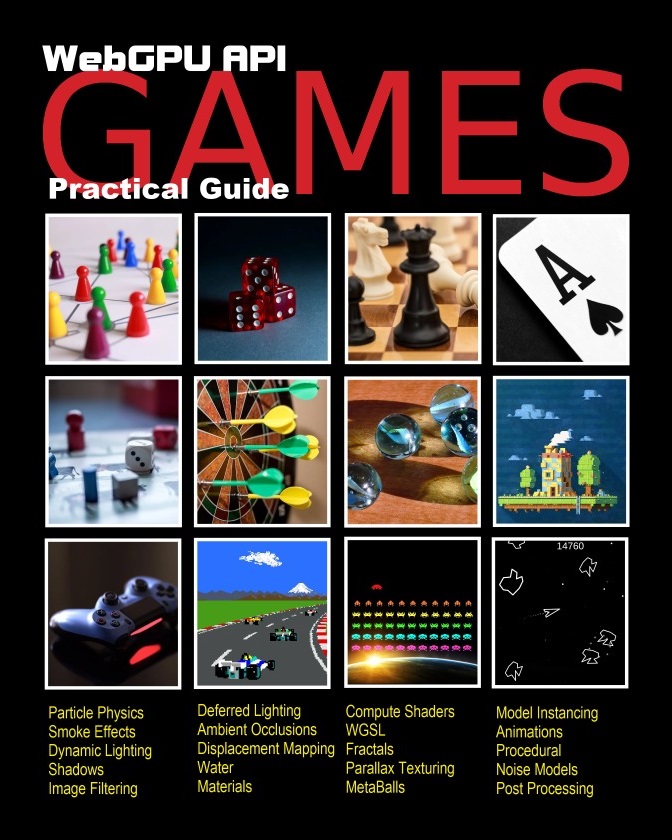
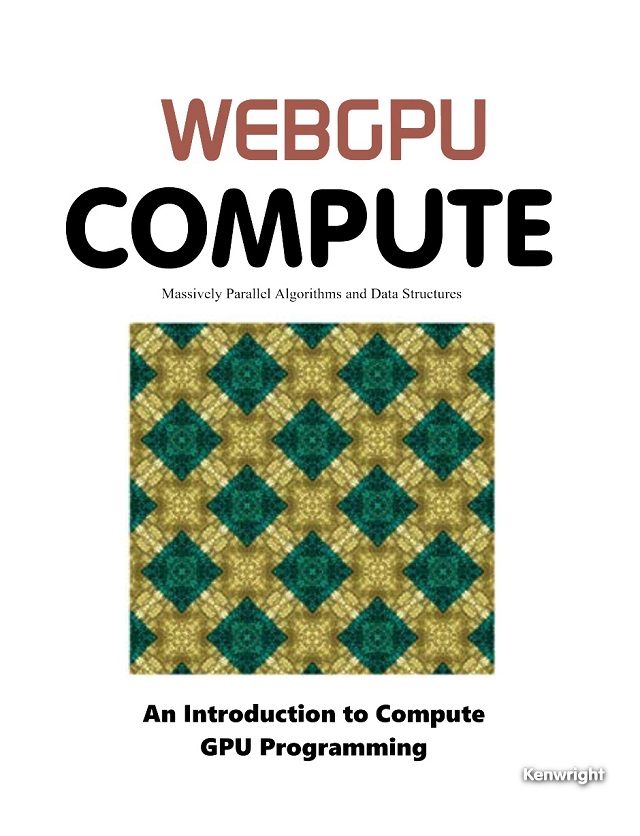






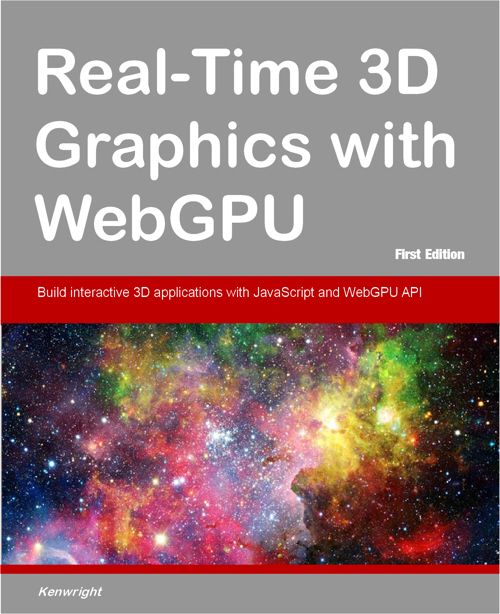




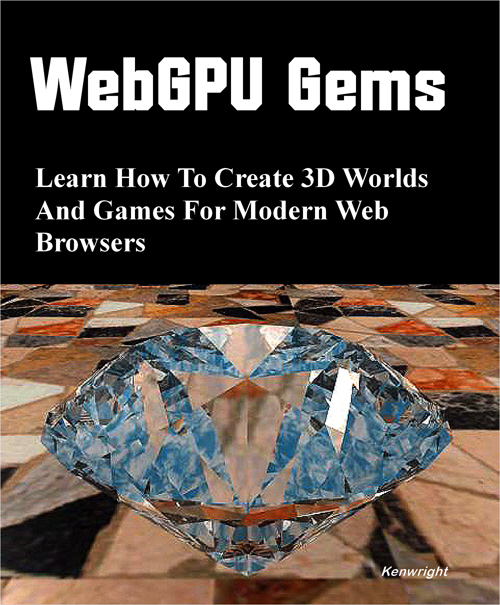







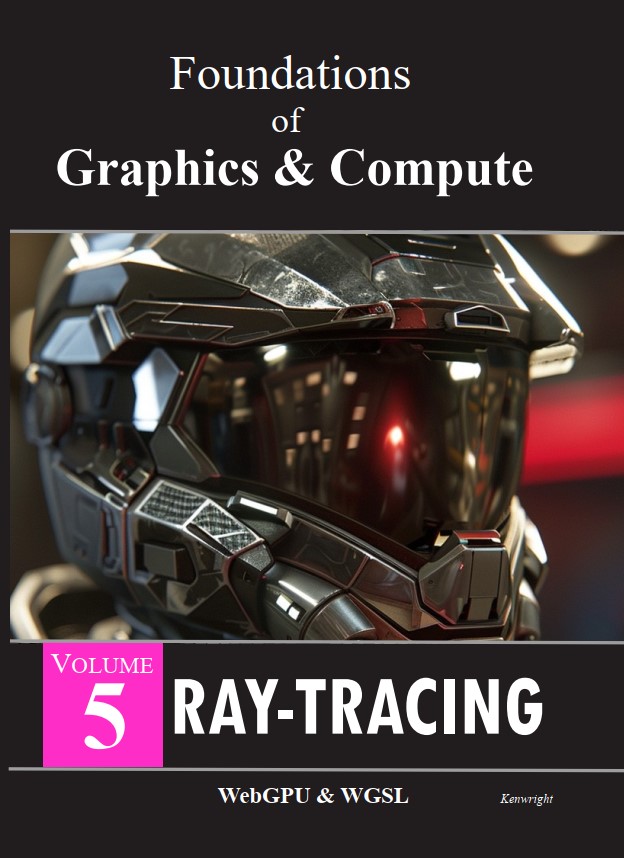
|
|